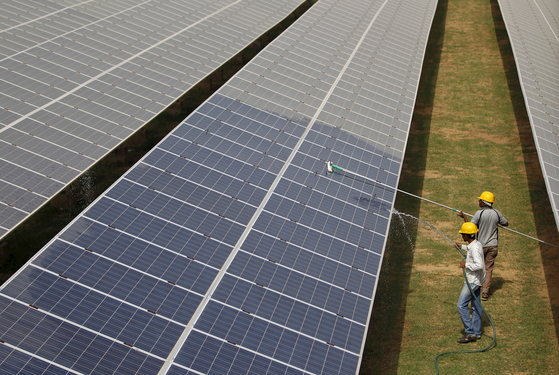
Wiping solar panel glass in Gujarat, India. In India and China, renewable energy prices are 25% cheaper than in the EU due to the influence of cheap resources and labor. Nevertheless, a study found that up to 4 more investments would be required by 2050 for decarbonization energy conversion in Asia, which had previously been highly dependent on coal. REUTERS=Yonhap News
In order to cope with climate change, the amount of investment required in Asia is estimated to exceed 4 kilograms. One scene is 10,000 times the amount of one trillion.
The Asian Investor Group (AIGCC) reported in the analysis report on’Asia’s Net Zero Energy Investment Potential’ published on the 4th, “To achieve’decarbonization’ by 2050, at least $26 trillion in Asian energy sectors , It is necessary to invest up to 37 trillion dollars (1773 trillion won for 4 scenes).” It is more than seven times the size of Korea’s 2021 budget (558 trillion won).
Up to 5,950 trillion won is required by 2050, mostly energy investment

Source AIGCC’Asia’s net zero energy investment potential’ report.
As climate change approaches, the Paris Convention signed in 2015 and the IPCC (Intergovernmental Panel on Climate Change) suggested that the global average temperature rise should be limited to 2℃ and further to 1.5℃.
AIGCC’s report stated, “The total investment potential generated from decarbonization by 2050 in Asia is $32.8 trillion (7031 trillion won) at 2℃, and $40.700 billion for the 1.5℃ target ( It is expected to be 5950 trillion won).”
In addition, it analyzed that “the amount of investment in the energy sector will amount to at least $25.900 trillion (based on 2℃) and up to $37.3 trillion (based on 1.5℃).” This means that 78-91% of the total investment potential is concentrated in the energy sector.
The amount of investment in the energy sector for decarbonization by 2050, as estimated by the report, amounts to 1.5% to 2% of the total GDP of Asia. Earlier, the IPCC estimated that 2.5% of GDP from 2016 to 2035 would need to be invested to meet the 1.5 degree target.
The report explained, “Because the prices of renewable energy in India and China, where labor and resources are cheap, are 25% cheaper than in the United States or the EU, it is considered to be less than the IPCC estimates.”
China, India, and Vietnam should be rich in resources, and Korea and Japan should import clean energy.

An offshore wind farm built in Hebei, China. 75 wind turbines are connected. AIGCC analyzed that China, India and Vietnam will be able to’decarbonize’ the energy market with abundant sunlight and wind resources. Xinhua=Yonhap News
In the report, AIGCC said, “Asia is a huge market that uses 43% of the world’s energy, and it is growing rapidly, and its dependence on coal is a large emission source that uses 76% of the world’s coal use.” “The shift in the energy sector, which accounts for %, is the key to decarbonization.”
The report cited the development of abundant solar and wind resources and storage means such as batteries and hydrogen as positive factors for decarbonization in Asia. AIGCC predicts that China, India, and Vietnam will achieve their targets for wind and solar energy by 2030, while Japan and South Korea, which lack these resources, expect to import clean energy.
AIGCC predicted that Asian countries spent 820 billion dollars (about 925 trillion) in fossil fuel imports in 2019, which would be equivalent to 25 trillion dollars (8225 trillion won) in the next 30 years, and this money could be turned into energy conversion. Rebekah Mikula Wright, senior director of AIGCC, said, “Among investors in Asia, the demand for investment in response to climate change is already large and growing. If we do not change the investment direction now, we will lose more and more.”
This report comprehensively analyzes the research of the World Energy Organization, Tsinghua University, and the International Institute of Applied Systems Analysis (IIASA). Japan is missing from the IIASA study, so the AIGCC borrowed data from other institutions related to Japanese decarbonization and analyzed it in an integrated manner.
Reporter Kim Jeongyeon [email protected]
![]()
